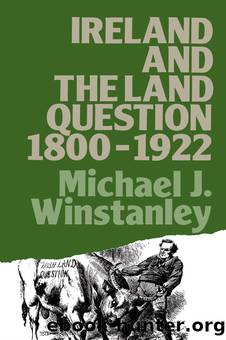Ireland and the Land Question 1800-1922 by Michael J. Winstanley

Author:Michael J. Winstanley [Winstanley, Michael J.]
Language: eng
Format: epub
Tags: History
ISBN: 9781135835538
Google: aeXMByx1ZuMC
Goodreads: 8410170
Publisher: Routledge
Published: 1984-10-18T00:00:00+00:00
Social unrest and political mobilization
AGRARIAN OUTRAGES AND RURAL VIOLENCE
Rural Ireland and its apparent endemic violence has received far more attention than the English countryside despite the fact that this, too, was far from an untroubled society, with major outbreaks of collective protest in the southern and eastern counties in 1816 and 1830â1 and persistent, often malicious crimes against persons and property. Although there are numerous examples of Irish unrest before the famine, precise figures are not available until the police began to compile detailed records from the mid-1830s. From 1844 a separate record of âagrarian outragesâ was compiled, although the criteria for distinguishing these from other rural crimes always remained obscure. Homicidesâlegitimized in some eyes as âassassinationsââassaults and other âoffences against the personâ attracted the most concern but formed only a small proportion of total outrages. More common were injuries to propertyâchiefly incendiarism and the maiming of animalsâand general âoffences against the public peaceâ, predominantly the sending of threatening letters. Although such crimes were to be found in England, they were usually the work of individuals acting independently; in Ireland they were generally perpetrated by sinister secret societies. These underground, locally based organizations seem to have enjoyed the complete loyalty which they demanded among significant sections of the rural community. Their exotic namesâShaunavests, Terry Alts, Rockites, Blackfeet, Molly Maguires, Whitefeet, Whiteboysâritual initiation ceremonies and oath-taking, further alarmed the authorities.
The first outbreaks of Whiteboyism, a term which is commonly used to cover the activities of all such societies, occurred in the 1760s but activity and concern seem to have peaked as population pressures mounted during the 1820s and 1830s. Participants were invariably drawn from the poorer strata of society, not the completely destitute or landless, but the smallholding and cottier classes. The rural disturbances, however, were not equally prevalent throughout the country. In Connaught and Ulster, where smallholders were most numerous, outrages were less frequent than in the more commercially orientated, advanced provinces of Leinster and Munster. Within this region there were frequent sporadic outbursts of collective activity. From the mid-1830s to the famine, Tipperary enjoyed the dubious distinction of being considered the most violent county, but no one area retained its lead for long and all were affected at some stage. This suggests that unrest was not simply a natural consequence of a backward, poverty-stricken peasant society but a response to deliberately engineered changes which threatened the foundations of that society.
Unravelling the motives of these societiesâ members, however, is far from easy. A few historians have suggested that their activities reflected the high spirits of the under-employed, adolescent age group, a large proportion of society during a period of population growth. Others have stressed the possibility of frequent family quarrels, especially over inheritances, which were bound to occur when access to land was so vital for survival. The recourse to collective intimidation by labourers and cottiers to assist negotiations with farmers over wages or conacre holdings cannot be ruled out; nor can the possibility of tenantsâ concern over rent levels.
Download
This site does not store any files on its server. We only index and link to content provided by other sites. Please contact the content providers to delete copyright contents if any and email us, we'll remove relevant links or contents immediately.
Room 212 by Kate Stewart(5040)
The Crown by Robert Lacey(4729)
Endurance: Shackleton's Incredible Voyage by Alfred Lansing(4683)
The Iron Duke by The Iron Duke(4293)
The Rape of Nanking by Iris Chang(4139)
Joan of Arc by Mary Gordon(4016)
Killing England by Bill O'Reilly(3953)
Say Nothing by Patrick Radden Keefe(3903)
I'll Give You the Sun by Jandy Nelson(3359)
Shadow of Night by Deborah Harkness(3307)
Hitler's Monsters by Eric Kurlander(3269)
Mary, Queen of Scots, and the Murder of Lord Darnley by Alison Weir(3152)
Blood and Sand by Alex Von Tunzelmann(3140)
Darkest Hour by Anthony McCarten(3072)
Eleanor & Park by Rainbow Rowell(3063)
Margaret Thatcher: The Autobiography by Thatcher Margaret(3029)
Red Famine: Stalin's War on Ukraine by Anne Applebaum(2874)
Book of Life by Deborah Harkness(2869)
The One Memory of Flora Banks by Emily Barr(2803)
